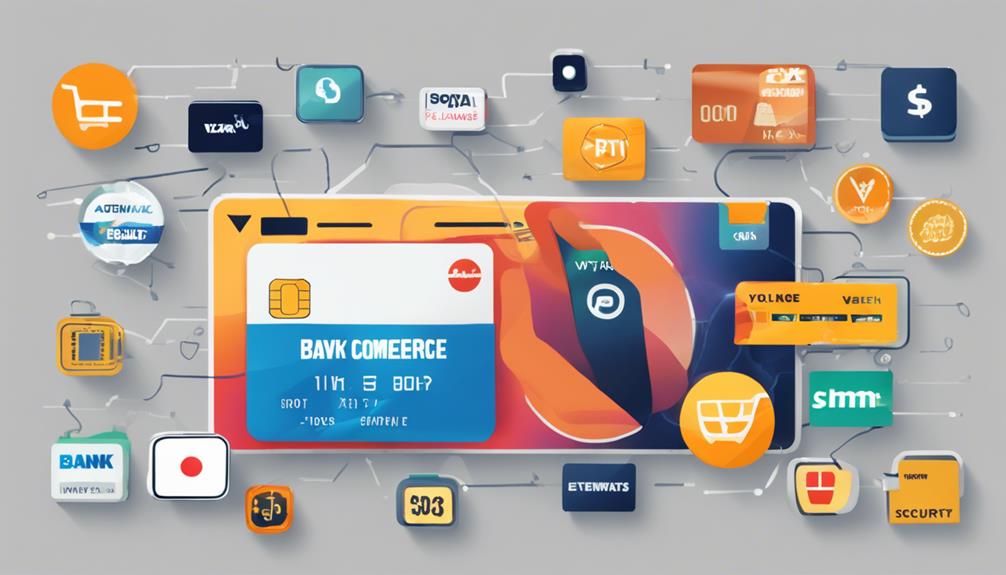Understanding the complex merchant acquiring landscape as a new ISO requires grasping fundamental concepts, establishing strategic partnerships with banks and processors, ensuring regulatory compliance, and prioritizing merchant relationship management. Comprehending how merchant accounts work, collaborating with reliable financial institutions, and adhering to industry standards are essential steps. Immerse yourself in the world of credit card networks to optimize costs and offerings for merchants. By focusing on clear communication, tailored services, and proactive merchant support, you can lay a strong foundation for sustainable growth. Unravel the nuances of this intricate process to propel your ISO journey towards success.
Key Takeaways
- Understand interchange fees to manage costs effectively.
- Tailor payment solutions to merchants' specific needs.
- Establish recurring revenue streams for financial stability.
- Offer personalized services to build strong merchant relationships.
- Stay informed about industry trends and regulations for compliance.
Understanding Merchant Acquiring Basics

When delving into the world of merchant acquiring, you must grasp the fundamental basics that underpin the acceptance and processing of credit card payments. Merchant acquiring involves the essential role of acquirers, financial institutions that facilitate the establishment and maintenance of merchant accounts, enabling businesses to accept card payments seamlessly.
These acquirers charge various fees for their services, including interchange fees determined by major card networks like Visa and Mastercard. In addition to managing payment processing, merchant acquiring also encompasses the deployment of essential tools such as POS terminals and online payment gateways to facilitate secure and efficient transactions for merchants.
Acquirers play a pivotal role in ensuring that payment processing isn't only efficient but also compliant with industry regulations, safeguarding both merchants and customers in the process. Understanding these core elements of merchant acquiring lays a solid foundation for handling the complex landscape of payment processing as an ISO.
Benefits of Becoming an ISO

Becoming an ISO opens up a world of opportunities in the domain of payment solutions and services, providing a gateway to a wide range of benefits for those looking to establish a foothold in the industry.
As an ISO, you gain access to a diverse network of payment solutions, allowing you to offer extensive payment processing options to merchants. This role not only enables you to provide tailored payment solutions customized to the specific needs of merchants but also creates a sustainable business model with recurring revenue streams.
By becoming an ISO, you can expand your reach and cater to businesses across all 50 states in the U.S. and Canada. The benefits of ISO status extend beyond just financial gains, offering you the chance to build long-lasting relationships with merchants and establish yourself as a trusted provider of payment solutions.
Embracing the role of an ISO can lead to a rewarding and fulfilling journey in the payment processing industry.
Steps to Register as an ISO

When registering as an ISO, the first step is understanding the registration requirements. You need to follow specific steps in the application process and guarantee compliance with industry standards and regulations.
Accreditation is a vital part of the process, so be prepared for thorough vetting to establish your credibility in the merchant acquiring landscape.
Registration Requirements Overview
To register as an ISO, establishing your business legally is the initial and fundamental step to guarantee compliance with regulations and industry standards. You must create a detailed business plan outlining goals, strategies, and financial projections for the ISO registration process.
Finding a sponsoring bank or payment processor is vital as they'll underwrite your ISO business and provide necessary infrastructure. Your business operations, financial stability, and compliance adherence will undergo scrutiny in the vetting process by the sponsoring bank or processor.
Registering with major credit card companies like Visa and Mastercard is essential to access their payment networks and offer card processing services as an ISO. Complying with registration requirements ensures a smooth entry into the merchant acquiring landscape.
Application Process Steps
Once you have secured a sponsoring bank or payment processor, the application process steps to register as an ISO can be initiated smoothly. To start this process, you need to establish your business legally to guarantee compliance with regulations. Creating a detailed business plan is vital as it outlines your goals, strategies, and financial projections for the ISO venture. Finding a sponsoring bank is essential to gain access to the necessary infrastructure and support in the payment processing industry. Expect to undergo a vetting process where potential partners scrutinize your business operations, financial stability, and adherence to industry standards. Registering with major credit card companies like Visa and Mastercard is a key requirement to offer credit card processing services as an ISO.
| Application Process Steps | ||
|---|---|---|
| 1. Establish business legally | 2. Create a detailed business plan | 3. Find a sponsoring bank |
| 4. Undergo vetting process | 5. Register with Visa and Mastercard |
Compliance and Accreditation
Registering as an ISO requires establishing legal business entities like LLCs or corporations to operate within the payments industry. Accreditation involves a detailed business plan outlining operations, target market, and growth strategies.
Finding a sponsoring bank is important for access to payment processing networks. ISOs must undergo vetting by industry regulators and compliance bodies to meet necessary standards in merchant acquiring.
Registering with major credit card companies such as Visa and Mastercard is essential for processing transactions. Compliance with regulations ensures ISOs operate ethically and legally.
Partnering with a reputable sponsor bank and adhering to industry standards are crucial steps in ISO registration. By following these guidelines, you can navigate the compliance and accreditation process successfully in the merchant acquiring landscape.
Partnering With Banks and Processors

Partnering with banks and processors forms the cornerstone of a successful ISO's access to essential infrastructure and backend support for seamless payment processing operations. In the domain of merchant processing, ISOs rely on acquiring banks for the financial backbone of payment transactions, while payment processors handle the technical aspects of transaction authorization and settlement.
By establishing strong relationships with these financial institutions, ISOs can secure better rates, expedited approvals, and enhanced support for themselves and their merchants. Banks and processors offer a suite of services encompassing fraud prevention, chargeback management, and reporting tools to streamline payment processing operations.
Effective communication and collaboration with banking partners and processors are crucial for ensuring smooth and secure payment processing. Additionally, understanding and adhering to compliance requirements and risk management protocols set by these entities are essential for maintaining successful merchant relationships.
Partnering with banks and processors not only facilitates the transaction process but also paves the way for sustainable growth in the merchant acquiring landscape.
Compliance and Registration Requirements

When setting up as an ISO, you must adhere to the PCI DSS for cardholder data security. It's mandatory to register with major credit card companies such as Visa and Mastercard for payment processing.
Background checks, financial reviews, and compliance with industry regulations are part of the typical ISO registration process.
Legal Compliance Essentials
Understanding legal compliance essentials is pivotal for successfully maneuvering through the merchant acquiring landscape as a new ISO. Here are five key points to keep in mind:
- Adhering to industry regulations is essential.
- Obtaining the necessary licenses is a must.
- Meeting all legal obligations within the merchant services industry is imperative.
- Staying informed about regulatory changes is crucial.
- Seeking guidance from legal experts can help guarantee compliance.
As a new ISO, it's imperative to prioritize legal compliance to avoid hefty fines, penalties, and potential license revocation. By staying proactive and informed, you can navigate the complex legal landscape of merchant acquiring successfully.
Registration Process Overview
To navigate the registration process successfully as an ISO in the merchant acquiring landscape, ensuring compliance with industry regulations and meeting registration requirements is essential. As you establish your business legally and craft a detailed business plan, finding a sponsoring bank or payment processor becomes vital in the registration process.
Undergoing a vetting process and registering with major credit card companies are fundamental compliance steps for ISO registration. Compliance with industry regulations and standards is necessary for a successful registration as an ISO.
Once you complete the registration process, you gain access to a broad network of payment solutions. This enables you to offer tailored payment services to merchants, meeting their specific needs in the field of merchant acquiring.
Navigating Credit Card Networks

Mastering the intricacies of credit card networks is essential for ISOs looking to enhance their merchant acquiring strategies. Understanding the nuances of Visa, Mastercard, and American Express can have a substantial impact on your business growth. Here are five key points to ponder:
- Interchange Fees: Each network sets fees that impact your costs and profitability.
- Acceptance Rates: Variances in acceptance can influence your merchants' sales potential.
- Cardholder Demographics: Knowing the typical users of each network can help tailor your offerings.
- Visa and Mastercard Dominance: These two networks hold significant market share globally, shaping industry trends.
- Optimizing Payment Solutions: Exploring the differences in networks allows you to provide competitive solutions and attract more merchants.
Managing Merchant Relationships

Pivoting from the intricacies of credit card networks, now let's explore the importance of managing merchant relationships in the merchant acquiring landscape.
As an ISO, nurturing strong merchant relationships is vital for your long-term success. Effective communication, transparency, and trust form the foundation of these relationships. By understanding the unique needs, goals, and challenges of each merchant, you can offer tailored payment solutions and exceptional service.
Proactive problem-solving and providing personalized attention are key in maintaining positive relationships. Regularly analyzing merchant performance, reviewing transaction data, and offering insights for optimization not only benefit the merchants but also strengthen the partnership.
This continuous effort towards partnership strengthening through communication, trust, and tailored solutions is essential for your success in the competitive merchant acquiring landscape. Remember, by focusing on personalized attention and proactive problem-solving, you can ensure that your merchant relationships thrive.
Growth Strategies for New ISOs

What strategies can new ISOs implement to foster growth in the merchant acquiring landscape? To achieve growth in the payment processing industry, consider the following tactics:
- Targeted Marketing Campaigns: Utilize content marketing, SEO, and social media advertising to attract merchants effectively.
- Leverage Referrals: Expand your portfolio by seeking referrals from existing merchant relationships and industry partners.
- Offer Tailored Solutions: Provide customized pricing, value-added services, and technology integration to meet unique merchant requirements.
- Streamlined Onboarding Process: Enhance the merchant acquisition experience with online applications and quick approvals.
- Excellent Customer Support: Retain merchants by offering 24/7 assistance, proactive communication, and swift issue resolution.
Frequently Asked Questions
What Is the Difference Between ISO and Merchant Acquirer?
The key distinction between an ISO and a Merchant Acquirer lies in their roles within the payment processing ecosystem.
An ISO, or Independent Sales Organization, serves as a mediator between merchants and payment processors, focusing on sales and relationship management.
On the other hand, a Merchant Acquirer is a financial institution that enables merchants to accept electronic payments by handling transaction processing, settlement, and risk management.
Understanding these differences is crucial for newcomers in the merchant acquiring industry.
What Is the ISO Program for Merchant Services?
To understand the ISO program for merchant services, it's like being the matchmaker between merchants and payment processors. You customize payment solutions and connect merchants to a wide range of payment options.
As an ISO, you're the go-to for credit card processing, POS systems, and tailored solutions. This role allows you to build a solid business and operate across multiple states and even in Canada.
What Is the Difference Between Payment Facilitator and Iso?
Payment Facilitators process payments for multiple merchants using their master account, while ISOs serve as intermediaries between merchants and payment processors, offering tailored solutions. Payment Facilitators focus on quick onboarding for smaller businesses, while ISOs provide a wide range of payment options and customized services for businesses of all sizes.
Understanding this distinction is crucial for new entrants in the merchant acquiring industry.
What Is a Registered ISO of Wells Fargo Bank?
As a Registered ISO of Wells Fargo Bank, you play a crucial role in connecting merchants with Wells Fargo Bank for payment processing solutions. This designation grants you access to a wide array of tailored payment options and POS systems to suit each merchant's unique needs.
To become a Registered ISO, you undergo a rigorous vetting process and meet Wells Fargo Bank's requirements. This partnership provides a robust network of payment solutions and support services for your merchant clients.
Conclusion
To sum up, becoming an ISO in the merchant acquiring industry can be a lucrative opportunity with the right strategies in place.
Did you know that the global merchant acquiring market is projected to reach $2.56 trillion by 2025?
By following the steps outlined in this guide, you can navigate the landscape successfully and grow your ISO business. In addition to mastering the landscape, it is also important to implement effective growth strategies for expanding clientele. This includes leveraging social media platforms, attending industry events, and reaching out to potential clients through targeted marketing campaigns. By consistently applying these strategies, you can attract new customers and continue to grow your ISO business.
Stay informed, stay compliant, and focus on building strong relationships with merchants for long-term success.
Good luck on your journey!











